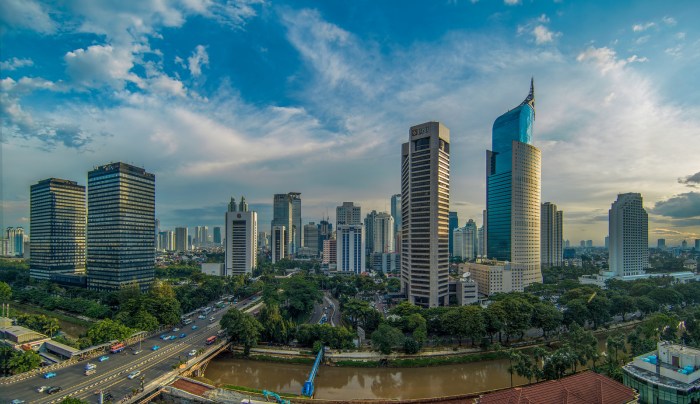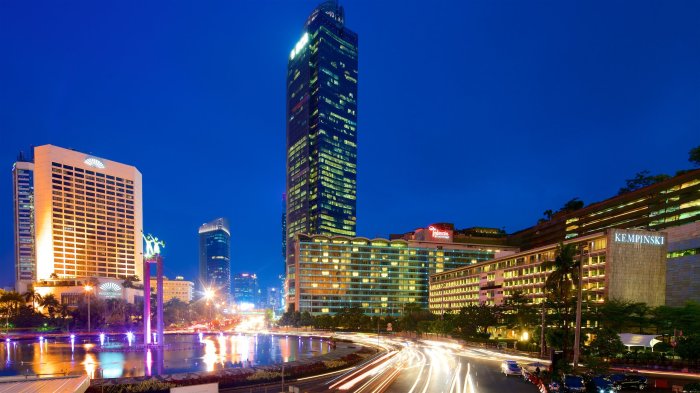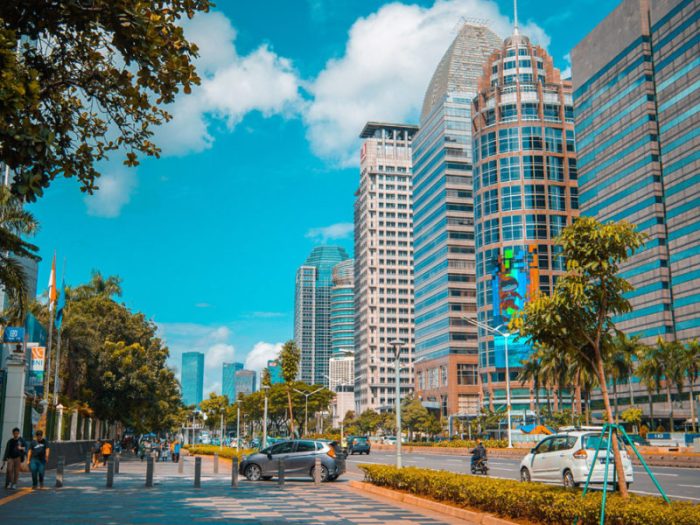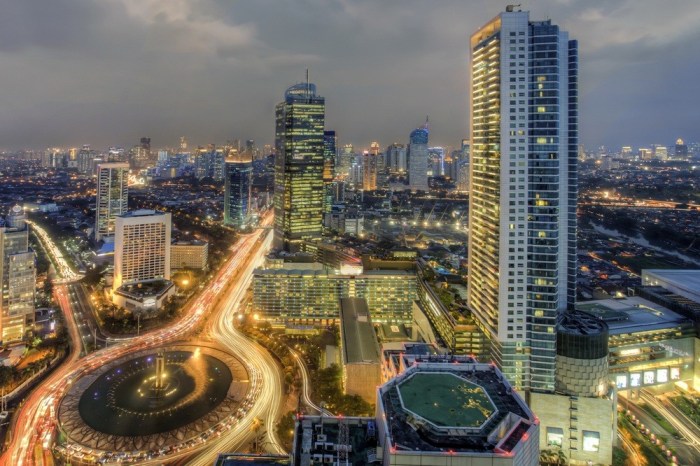Central Jakarta, the pulsating heart of Indonesia’s bustling capital, is a captivating blend of history, culture, and modernity. From its iconic landmarks to its thriving business district, this dynamic city district has much to offer.
This comprehensive guide will take you on a journey through the multifaceted tapestry of Central Jakarta, exploring its rich heritage, economic significance, infrastructure, population, attractions, and the challenges and opportunities that shape its future.
Geographic Significance

Central Jakarta is the beating heart of the greater Jakarta metropolitan area, Indonesia’s bustling capital. It is strategically located in the center of the city, bordered by North Jakarta to the north, East Jakarta to the east, South Jakarta to the south, and West Jakarta to the west.Central Jakarta is home to many iconic landmarks, including the National Monument (Monas), the Istiqlal Mosque, and the Jakarta Cathedral.
Central Jakarta, the heart of Indonesia’s capital, is a vibrant hub of commerce and culture. If you’re seeking a tranquil escape from the city’s hustle and bustle, consider a trip to uluwatu bali , a picturesque coastal paradise. Known for its stunning beaches, towering cliffs, and ancient temples, Ubud offers a rejuvenating getaway.
Upon your return to Central Jakarta, you’ll find yourself refreshed and ready to embrace the city’s vibrant energy once more.
It is also the center of government and business, with many government offices and corporate headquarters located within its boundaries.
Historical Evolution

Central Jakarta’s history dates back to the 16th century when the Dutch established Batavia, the predecessor of Jakarta, on the banks of the Ciliwung River. The area around what is now Central Jakarta served as the administrative and political center of Batavia, and it remained so after Indonesia gained independence in 1945.
Administrative and Political Center
Central Jakarta has always been the heart of Jakarta’s administrative and political life. The area is home to the Presidential Palace, the National Parliament Building, and numerous government ministries and agencies. It is also the location of the Jakarta City Hall and the headquarters of the Jakarta Police.
Historical Events and Figures
Central Jakarta has been the site of many significant historical events and has been associated with many notable figures. In 1656, the Chinese community in Batavia was massacred by Dutch soldiers, an event known as the “Chinese Massacre.” In 1811, the British invaded Batavia and occupied the city for five years.
During the Indonesian National Revolution, Central Jakarta was the site of fierce fighting between Indonesian nationalists and Dutch forces.One of the most famous figures associated with Central Jakarta is Sukarno, the first president of Indonesia. Sukarno was born in Surabaya in 1901, but he spent much of his life in Central Jakarta.
He lived in the Menteng area, and he often gave speeches from the balcony of his house. Sukarno was a key figure in the Indonesian National Revolution, and he played a major role in shaping the country’s early history.
Central Jakarta, the bustling heart of the Indonesian capital, offers a vibrant blend of history and modernity. If you seek a respite from the urban sprawl, consider venturing to Harapan Indah Bekasi , a verdant oasis just beyond the city limits.
This self-contained township boasts tranquil parks, charming neighborhoods, and an array of amenities, making it an ideal retreat for those seeking a balance between city life and suburban serenity. From Harapan Indah Bekasi, it’s a short commute back to the vibrant streets of Central Jakarta, where the hustle and bustle of the metropolis await.
Cultural Heritage

Central Jakarta, the heart of Indonesia’s capital, boasts a rich cultural heritage that has shaped its identity and development. From traditional arts and crafts to vibrant festivals and landmarks, the city’s cultural tapestry is a reflection of its diverse history and vibrant spirit.
Traditional Arts and Crafts
Central Jakarta is renowned for its exquisite traditional arts and crafts. Wayang kulit, the intricate shadow puppet theater, has been a beloved art form for centuries, captivating audiences with its elaborate puppets and enchanting storytelling. The city is also home to skilled batik artisans, who create stunning fabrics adorned with intricate patterns and vibrant colors.
Cultural Landmarks and Institutions, Central jakarta
Central Jakarta is dotted with cultural landmarks and institutions that showcase its heritage. The National Museum of Indonesia houses a vast collection of artifacts and exhibits that chronicle the nation’s history and cultural diversity. The Istiqlal Mosque, one of the largest mosques in Southeast Asia, stands as a symbol of the city’s religious heritage.
The Taman Ismail Marzuki Arts Center is a hub for performing arts, hosting a wide range of theater, dance, and music performances.
Influence on City Identity
Central Jakarta’s cultural heritage has played a pivotal role in shaping the city’s identity. The city’s vibrant festivals, such as the Jakarta International Arts Festival and the Jakarta Fair, showcase the diverse cultural expressions of the city’s residents. Traditional arts and crafts are not only preserved as cultural relics but also incorporated into modern design and fashion, reflecting the city’s dynamic and evolving cultural landscape.
Economic Importance

Central Jakarta serves as a pivotal business and financial hub for Indonesia. It is the home to numerous major corporations, banks, and financial institutions, contributing significantly to the city’s and national economy.
The presence of these establishments has fostered a vibrant business environment, attracting both domestic and international companies to establish their headquarters or regional offices in the area. The financial institutions, including banks and investment firms, play a crucial role in facilitating capital flow and supporting economic growth.
Economic Contributions
Central Jakarta’s economic contributions are substantial. It is estimated that the district generates approximately 20% of Jakarta’s GDP and contributes significantly to Indonesia’s national economy.
- Corporate Presence:Central Jakarta is home to the headquarters of many large Indonesian corporations, such as Bank Mandiri, Telkom Indonesia, and Astra International.
- Financial Hub:The district is a major financial center, hosting the headquarters of the Indonesian Stock Exchange and the offices of numerous banks, including Bank Central Asia and Bank Rakyat Indonesia.
- Tourism and Hospitality:Central Jakarta attracts both domestic and international tourists, contributing to the district’s economy through hotels, restaurants, and entertainment venues.
Infrastructure and Transportation

Central Jakarta boasts a well-developed infrastructure that supports its economic and social development. The transportation system is efficient and comprehensive, providing various options for commuting within the city and beyond.
Public Transportation
Central Jakarta has an extensive public transportation network that includes buses, trains, and taxis. The TransJakarta bus system is a key component, with dedicated bus lanes and a network of routes connecting different parts of the city. The MRT Jakarta (Mass Rapid Transit) provides a modern and efficient rail service, with several stations located in Central Jakarta.
Taxis are also widely available, offering a convenient mode of transportation for shorter distances.
Infrastructure Development
The infrastructure in Central Jakarta is continuously being upgraded and expanded to meet the growing needs of the city. New roads, bridges, and flyovers have been constructed to improve traffic flow and reduce congestion. The government is also investing in the development of smart city initiatives, such as intelligent traffic management systems and integrated public transportation ticketing.
Economic Impact
The efficient transportation system in Central Jakarta plays a vital role in supporting the city’s economy. It enables businesses to move goods and services quickly and efficiently, reducing costs and increasing productivity. The availability of reliable public transportation also attracts workers and professionals to the city, contributing to its economic growth.
Social Impact
The well-connected transportation system in Central Jakarta enhances the quality of life for its residents. It provides affordable and convenient options for commuting, reducing travel times and improving accessibility to employment, education, and healthcare facilities. The efficient transportation system also fosters social interaction and connectivity within the city.
Population and Demographics

Central Jakarta is a densely populated area with a diverse population. As of 2023, it has an estimated population of over 1.3 million, with a population density of approximately 16,000 people per square kilometer.
The population of Central Jakarta is relatively young, with a median age of 32. The majority of the population is of Javanese descent, followed by Sundanese, Betawi, and Chinese.
Central Jakarta, the bustling heart of Indonesia’s capital, offers a vibrant blend of modern skyscrapers and historic landmarks. Yet, amidst the urban hustle, there’s a tranquil oasis just a short drive away: Swiss Serpong. This charming Swiss-themed town transports visitors to a world of alpine architecture, serene lakes, and picturesque gardens.
While Swiss Serpong offers a welcome respite from the city’s intensity, it’s conveniently located, making it easy to return to the vibrant streets of Central Jakarta for a complete urban experience.
Social and Cultural Diversity
Central Jakarta is a melting pot of cultures, with people from all over Indonesia and the world calling it home. This diversity is reflected in the area’s many languages, religions, and traditions.
The majority of the population is Muslim, but there are also significant Christian, Buddhist, and Hindu communities. The area is also home to a number of cultural institutions, including museums, theaters, and art galleries.
Population Dynamics
The population dynamics of Central Jakarta have played a significant role in shaping the development and character of the area.
- The high population density has led to the development of a vibrant and bustling urban environment.
- The young population has contributed to the area’s dynamic and innovative culture.
- The diversity of the population has made Central Jakarta a tolerant and welcoming place for people from all backgrounds.
Tourism and Attractions

Central Jakarta boasts a diverse array of tourist attractions and landmarks that cater to both domestic and international visitors. These attractions not only showcase the rich cultural heritage of the city but also contribute significantly to its economy and cultural development.
National Museum of Indonesia
Established in 1778, the National Museum of Indonesia is the oldest and largest museum in Southeast Asia. It houses an extensive collection of artifacts and exhibits that trace the history and culture of Indonesia from prehistoric times to the present day.
Monas (National Monument)
Monas is a towering monument located in the heart of Jakarta. It commemorates Indonesia’s struggle for independence and offers panoramic views of the city from its observation deck.
Istiqlal Mosque
Istiqlal Mosque is the largest mosque in Southeast Asia. Its unique architecture and capacity to accommodate over 200,000 worshippers make it a popular destination for both religious and cultural tourists.
Kota Tua (Old Town)
Kota Tua is a historic district that preserves the colonial heritage of Jakarta. Its cobblestone streets, Dutch-style buildings, and museums provide a glimpse into the city’s past.
Thamrin City Shopping Mall
Thamrin City is one of the largest shopping malls in Southeast Asia. It offers a wide range of retail stores, restaurants, and entertainment options, making it a popular destination for both locals and tourists.
Challenges and Opportunities

Central Jakarta faces several challenges that hinder its progress and development. One of the most pressing issues is traffic congestion, which leads to air pollution, noise, and a decline in the quality of life. The high population density and limited infrastructure contribute to this problem.
Additionally, social inequality persists, with a significant gap between the wealthy and the poor.Despite these challenges, Central Jakarta presents numerous opportunities for improvement. The government is implementing initiatives to reduce traffic congestion, such as promoting public transportation and implementing traffic management systems.
Furthermore, there is a growing emphasis on sustainability, with initiatives aimed at reducing air pollution and promoting green spaces. Additionally, the government is working to address social inequality by providing affordable housing and expanding access to education and healthcare.By addressing these challenges and leveraging its opportunities, Central Jakarta can transform itself into a more sustainable, equitable, and prosperous region.
The city has the potential to become a model for urban development, showcasing how a metropolis can overcome challenges and achieve a high quality of life for its residents.
Traffic Congestion
Traffic congestion is a major challenge in Central Jakarta, resulting in significant delays, increased pollution, and reduced productivity. The high population density and limited infrastructure contribute to this problem.The government is implementing several initiatives to address traffic congestion. One key strategy is promoting public transportation.
The city is expanding its bus and train networks and implementing measures to make public transportation more accessible and efficient. Additionally, the government is encouraging the use of alternative modes of transportation, such as cycling and walking.Another approach to reducing traffic congestion is implementing traffic management systems.
These systems use technology to optimize traffic flow and reduce congestion. For example, the government is installing intelligent traffic lights that can adjust to changing traffic patterns in real-time.
Pollution
Air pollution is another significant challenge in Central Jakarta. The high volume of traffic and industrial activities contribute to the release of harmful pollutants into the air. This pollution poses health risks to residents and can also damage the environment.The government is taking steps to reduce air pollution.
One strategy is promoting the use of cleaner energy sources. The city is encouraging the adoption of electric vehicles and investing in renewable energy projects. Additionally, the government is implementing stricter emissions standards for vehicles and industries.Another approach to reducing air pollution is increasing green spaces.
Trees and plants help absorb pollutants and improve air quality. The government is planting trees and creating new parks and green spaces throughout Central Jakarta.
Social Inequality
Social inequality is a persistent challenge in Central Jakarta. The city has a significant gap between the wealthy and the poor. This inequality is reflected in disparities in access to education, healthcare, and housing.The government is working to address social inequality by providing affordable housing and expanding access to education and healthcare.
The city is building new affordable housing units and implementing rent control measures. Additionally, the government is expanding access to healthcare by providing free or low-cost health insurance to low-income residents.
Ultimate Conclusion: Central Jakarta

As we conclude our exploration of Central Jakarta, it is evident that this vibrant city district is a testament to Indonesia’s rich history, cultural diversity, and economic prowess. While challenges remain, Central Jakarta’s resilience and potential for growth promise an exciting future for this dynamic heart of the nation.
Commonly Asked Questions
What are the boundaries of Central Jakarta?
Central Jakarta is bordered by North Jakarta to the north, East Jakarta to the east, South Jakarta to the south, and West Jakarta to the west.
What is the population of Central Jakarta?
As of 2020, the population of Central Jakarta is estimated to be around 1.2 million.
What are some of the major landmarks in Central Jakarta?
Some of the major landmarks in Central Jakarta include the National Monument (Monas), the Istiqlal Mosque, the Jakarta Cathedral, and the Merdeka Palace.
What are some of the challenges faced by Central Jakarta?
Some of the challenges faced by Central Jakarta include traffic congestion, air pollution, and social inequality.